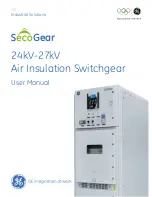
55
www.mader.eu
© Mader GmbH & Co. KG, Änderungsdatum
September 2019
5
4
3
2
Betriebsanleitung Rundschalteinheiten
5
4
3
1
2
6
8
7
1
Rundschalteinheiten RSE-K-6 und RSE-K-9
5
Für diese Rundschalteinheitentypen sind
diverse Zubehörteile verfügbar. Manche
dieser Teile sind, je nach Bestellung, in Ihre
Rundschalteinheit eingebaut oder wurden
mitgeliefert. Nähere Informationen über
diese Zubehörteile entnehmen Sie bitte
dem Kapitel 10.1.1.
5.2 Funktionsweise der RSE-K-6-... und
RSE-K-9-...
Das vorgeschaltete Magnetventil erhält ent-
weder ein Startsignal von der SPS oder einem
Taster. Das Ventil wird dadurch so geschaltet,
dass der Anschluss A mit Druckluft beauf-
schlagt wird. Die Druckluft drückt den Verrie-
gelungszylinder aus der Verriegelungsposition
und bewegt den Kolben von Endlage A zu
Endlage B.
Die Kolbenzahnstange greift dabei in das Zahn-
segment, dadurch wird die lineare Bewegung
in eine rotatorische Bewegung des Zahnseg-
ments umgesetzt. Die rotatorische Bewe-
gung des Zahnsegments wird mittels eines
Mitnehmerriegels auf den Schaltteller über-
tragen. Ein Kolbenhub entspricht dabei einer
Bewegung des Schalttellers von einer Teilung
zur nächsten Teilung.
Gleichzeitig wird bei dieser Bewegung des
Kolbens eine Zwangsöffnung frei. Die Druck-
luft wird über diese Zwangsöffnung und den
Anschluss Y zum Magnetventil geführt und
schaltet das Ventil so, dass nun Anschluss B
mit Druckluft vom Netz beaufschlagt wird.
Der Verriegelungszylinder wird nun in seine
Verriegelungsposition gefahren, der Mit-
nehmerriegel wird ausgeklinkt, der Kolben
wird von Endlage B zu Endlage A gefahren und
das Ventil wird wieder in seine Grundstellung
geschaltet.
Mit einem wiederholten Startsignal von der
SPS oder einem Taster beginnt der beschrie-
bene Zyklus von neuem.
Various accessories are available for these
rotary unit types. Some of these parts are,
depending on the order, built into your ro-
tary unit or were delivered with it. You can
find more information on these accessories
in the „Accessory“ section topic 10.1.1.
5.2 Mode of operation of the RSE-K-6-...
and RSE-K-9-...
The preceding solenoid valve either receives
a starting signal from the PLC or a switch.
This switches the valve so that connection A is
applied compressed air. The compressed air
pushes the locking cylinder out of the locking
position and moves the piston from limit positi-
on A to limit position B.
The piston gear rack engages the toothed
segment thereby transforming the linear mo-
vement into a rotary movement of the toothed
segment. The rotary movement of the toothed
segment is transferred to the indexing plate via
a driving bolt. One piston stroke is equal to one
indexing plate movement from one partition to
the next partition.
At the same time, a positive opening operation
is freed by this piston movement. The com-
pressed air is led to the solenoid valve via this
positive opening operation and connection Y
which switches the valve so that connection B
is now applied compressed air from the sys-
tem.
The locking cylinder is now moved into its
locking position, the driving bolt is disengaged,
the piston is moved from limit position B to
limit position A and the valve is switched back
into its initial position.
A repeated start signal from the PLC or a
switch restarts the cycle described.
















































